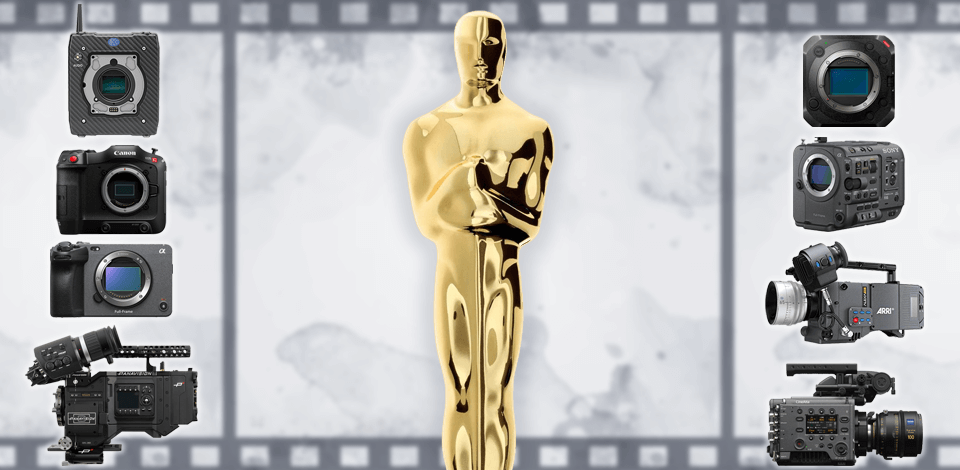
Working as a part of the FixThePhoto team, I’ve reviewed a lot of equipment, but cinema cameras have always remained one of my favorites and not because they are expensive. This year, my team and I decided to thoroughly test over 20 camera bodies from popular and recommended brands.
We have been using them for weeks in all sorts of conditions to see how they function in dynamic indoor and outdoor lighting environments and check whether we can recreate the style of the iconic La La Land movie that was filmed by Arri Alexa XT Plus camera ($7,295).
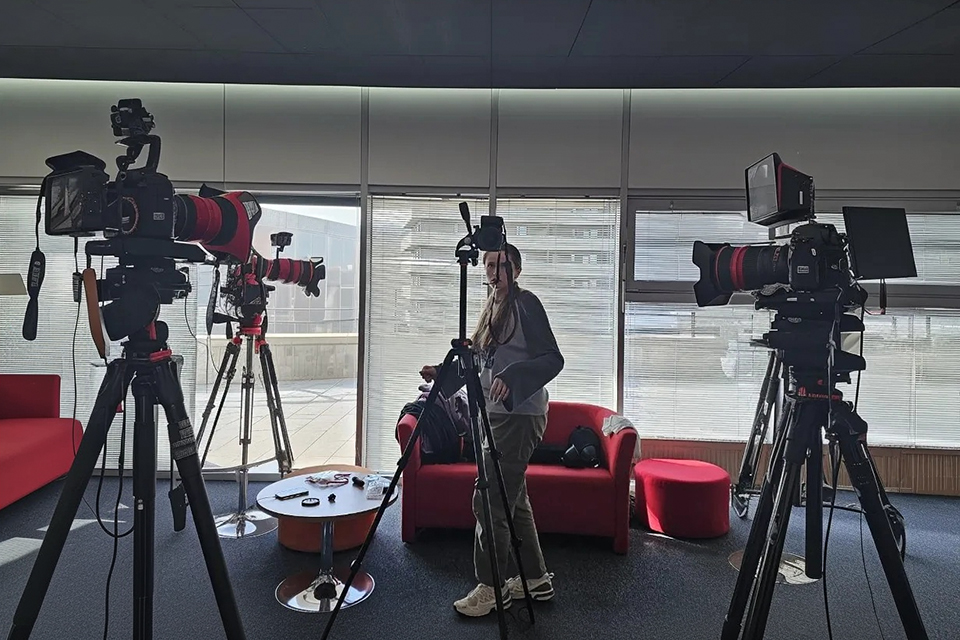
Besides, we wanted to shoot dynamic scenes in the Mad Max style, shoot content in handheld mode like in The Revenant, and use these cameras for long hours. We were also curious about the advanced focus-tracking capabilities supported by these cameras and how easy it would be for our editors to do color grading on the output footage.
My FixThePhoto colleagues and I would use these movie cameras daily and then analyze the quality of the captured footage. Then, we would spend long hours editing the files to see whether there were any imperfections. It helped us to identify the key selling points of these cameras.
If you are looking for the best movie camera in the world, on this list, you will find plenty of reliable models with handy tips based on our experience and models our clients-videographers use. Besides, we have included cameras that are used for Netflix productions and analyzed current trends to provide you with helpful insights.
They are not necessarily the most expensive. However, some of them are extremely difficult to find. You won’t be able to purchase IMAX cameras, as these custom-built models were specifically designed for high-budget productions.
Sony FX30  ★★★★★ (5/5)
★★★★★ (5/5)
After testing out a variety of models, the FixThePhoto video editors’ team and I can conclude that the Sony FX30 is one of the best cinema cameras available today. It is known for its budget price, powerful performance, and functionality. Due to its portable design, it can be used in handheld mode or for shooting on a gimbal
My colleagues and I wanted to find the most reliable options in high-end and budget market segments that stand out for their extensive functionality. On this list, you will find models that are preferred by both indie filmmakers and studio professionals.
From the very beginning, we decided to test these video cameras in real-world situations. We used them both in controlled studio settings and outdoor locations to see whether they are suitable for capturing fast-paced scenes and deliver consistent performance in different lighting situations. During the testing stage, we focused on resolution, dynamic range, and signal to noise ratio.
When testing these cinematographic cameras, we considered the following criteria:
Compact and ergonomic design
|
|
500+ bought in the past month |

|
100+ sold in the past year
|
|
|
40+ sold in the past year |

|
80+ sold in the past year
|
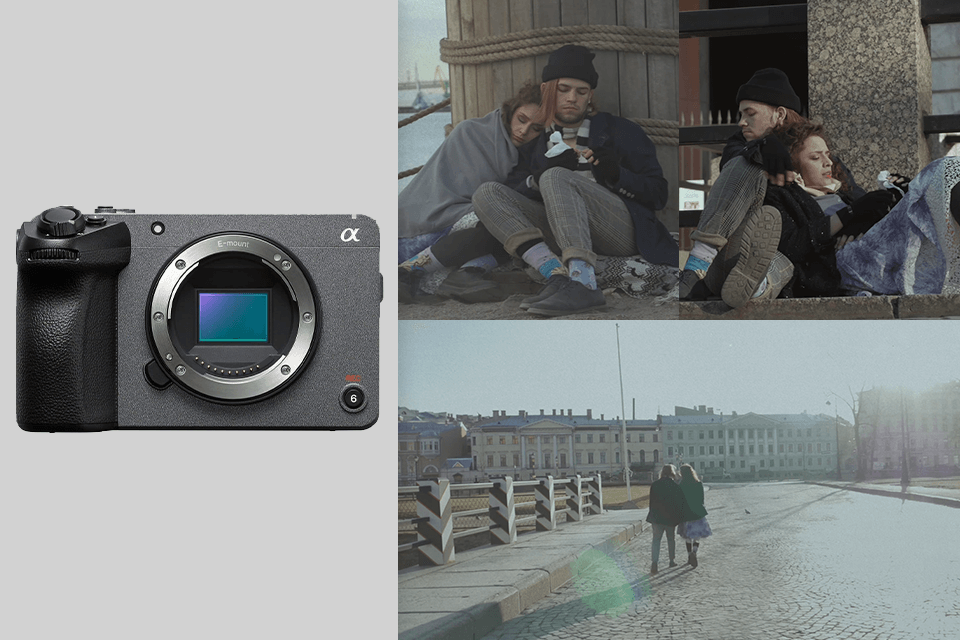
Sony FX30 is a budget video camera that deservedly tops our list. I wanted to learn whether it is suitable for creating social media content.
Affordable cinematic cameras are often overlooked by those who want to shoot at a professional level. I started to test it when shooting videos outdoors, trying to capture dynamic footage and record cityscapes. I like its impressive dynamic range and superb AF system.
This modern movie camera tracks moving subjects at an advanced level, which helped me capture the most important moments. I also tested it in poor-light conditions when working inside a café to recreate the effect seen in the Amélie movie. I wanted to check whether it will be possible to use it to capture small details like steam over a coffee cup or light reflections. The Dual Base ISO and 14+ stop dynamic range allow it to cope with any task. Even when I worked with high ISO, I did not notice a lot of noise. It helped me capture a video with an impressive level of detail in highlights and shadows.
My colleague Kate from FixThePhoto tested its Cine EI Quick and Cine EI Log shooting modes when working on her YouTube project. She also used LUTs during filming, as this camera allows videographers to apply them to the LCD display and HDMI output to avoid color grading issues.
The quality of the output video was excellent - the footage had a recognizable cinematic feel, so there was not any need to perform advanced color grading afterward.
I put the Sony FX30 at the top of my list because it's affordable and delivers professional quality. It's small enough to take anywhere, has a fantastic 4K sensor, and is incredibly user-friendly. Besides, it is a perfect choice for anybody – from seasoned filmmakers to complete beginners.
✔️ Buy it if: You’re a filmmaker or content creator who wants to shoot pro-level 4K footage without getting broke and needs to find a camera capable of capturing videos with minimal noise even in low-light scenarios.
| Specs | Outcome |
|---|---|
|
Resolution |
2160p, 1080p
|
|
Optical zoom
|
3 multiplier x
|
|
Aspect ratio |
1.50:1, 16:9
|
|
Connectivity tech
|
Wi-Fi, NFC, Bluetooth
|
|
Customer ratings
|
(4.8/5) ★★★★☆
|
Easily adaptable to any shooting situations
|
|
400+ bought in the past month
|

|
100+ sold in the past year
|
|
|
150+ sold in the past year
|

|
50+ sold in the past year
|
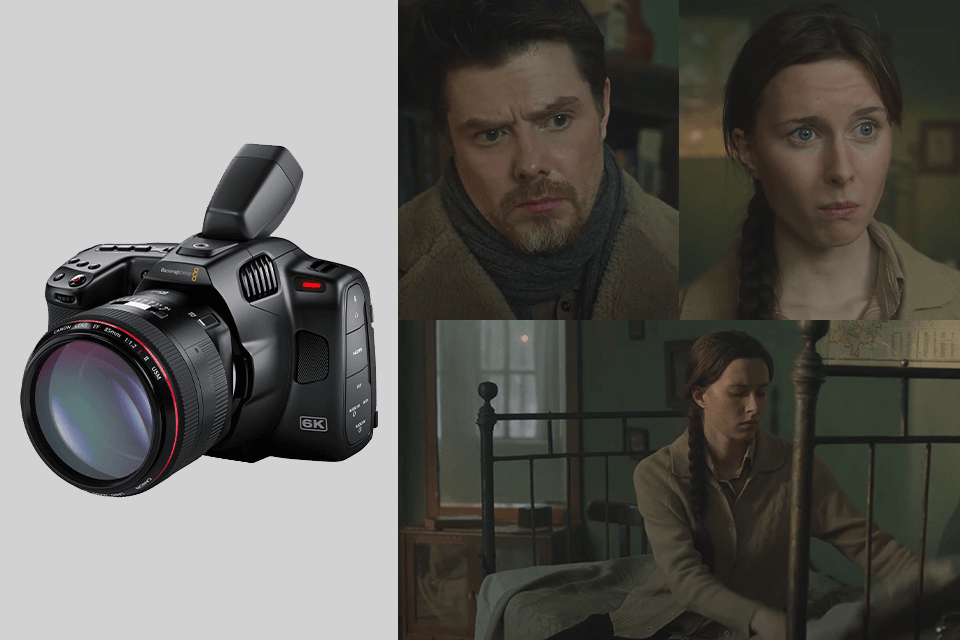
Even though I have never worked with the Blackmagic Pocket 6K Pro, after a few weeks of using it in our New York studio and outdoors, I realized why it is considered one of the best cinema cameras available today.
What struck me immediately about this low light video camera is its design. I was pleased with the accessibility of its buttons, which allowed me to quickly adjust ISO, shutter speed, and white balance. Another advantage is its tilting 5-inch LCD touchscreen. I was able to control the shooting process, whether I was working in handheld mode or using a tripod.
When testing this camera, I decided to use it in low-light situations to check whether it would be able to capture footage without noticeable noise. Then, I tested it in a studio setting and used LED panels to recreate an effect from True Detective and capture a scene in dramatic light. When I adjusted ISO up to 8,000, there was minimal noise. It makes this model stands out among other movie cameras sold in this price range.
Even though I was initially pleased with its compact design, I quickly discovered that I needed to use a cage to use an external monitor and microphone. It added some extra weight to my setup and helped me stabilize the camera.
The Blackmagic Pocket 6K Pro is a fantastic camera, which occupies the second place. The image quality is amazing and you can record raw footage. Besides, it has built-in ND filters but lacks autofocus. The color grading flexibility is unmatched.
✔️ Buy it if: You’re an independent filmmaker and want to shoot in 6K when working on cinematic projects or need to record footage with extra resolution to crop your videos.
| Specs | Outcome |
|---|---|
|
Resolution |
6K
|
|
Optical zoom
|
2 multiplier x
|
|
Aspect ratio |
16:9
|
|
Connectivity tech
|
Wi-Fi
|
|
Customer ratings
|
(4.5/5) ★★★★☆
|
Real-time eye autofocus
|
|
300+ bought in the past month
|

|
50+ sold in the past year
|
|
|
50+ sold in the past year
|
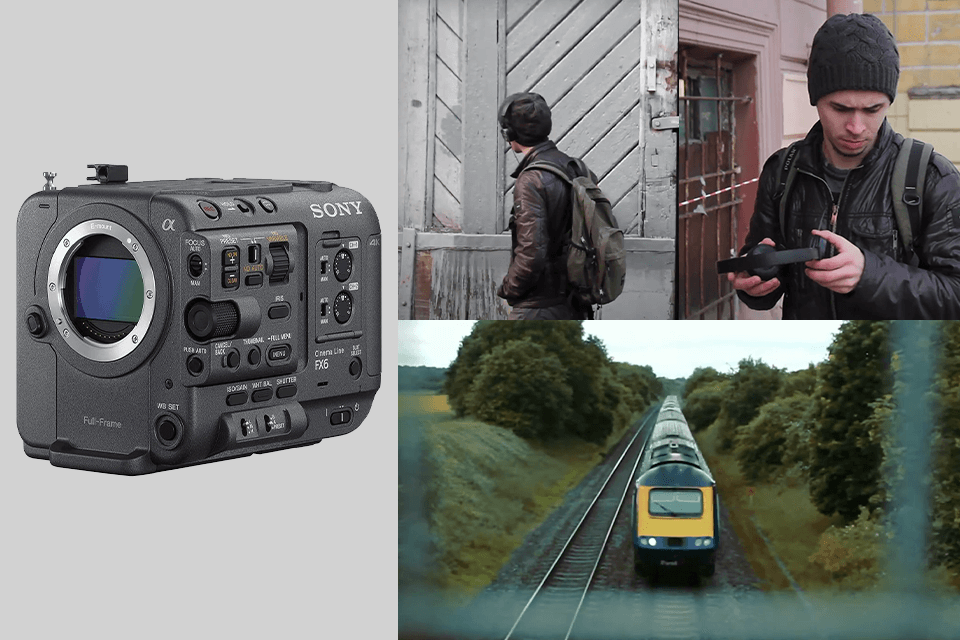
The first time when I used the Sony FX6 was during the holiday season. I was pleased with its performance. Recently, I decided to test it out again to check if my initial impression was accurate.
It surpassed my expectations once again. The key selling point of this 4K video camera is that it has a powerful cooling vent mounted along its right side. It allows it to support excellent processing power.
When working in a studio setting, I was able to make the most out of its 10.2MP full-frame sensor and recreate the style of Skyfall. When capturing 4K footage with S-Log 3, I captured videos with perfect contrast and detailed textures.
Unlike other professional movie cameras, it is especially suitable for capturing interior scenes in poorly-lit environments. The details were perfectly visible both in dark and light areas. The in-built ND sensor facilitates achieving the right exposure during continuous takes.
To test its ISO settings, I decided to shoot a video in a dimly lit environment with extra light sources. This dynamic range camera was able to capture clear footage even at ISO 409,600. The back-illuminated Exmor R CMOS sensor helped me to capture footage with a reduced noise level, making it perfect for shooting low-light documentaries and other videos.
The Sony FX6 comes in third on my list. It demonstrates good performance in low light and allows you to use variable ND filters. However, it isn't the cheapest option. Besides, it may take some time to get used to all its features.
✔️ Buy it if: You work as a freelance cinematographer, indie filmmaker, or documentary filmmaker and want to find a lightweight cinema camera for shooting documentaries or corporate videos. Besides, this camera is used for Netflix productions.
| Specs | Outcome |
|---|---|
|
Resolution |
4K, 2K
|
|
Optical zoom
|
2 multiplier x
|
|
Aspect ratio |
16:9
|
|
Connectivity tech
|
Wi-Fi, USB, HDMI, NFC
|
|
Customer ratings
|
(4.4/5) ★★★★☆
|
High speed for slow motion
|
|
150+ bought in the past month
|

|
150+ sold in the past year
|

|
100+ sold in the past year
|
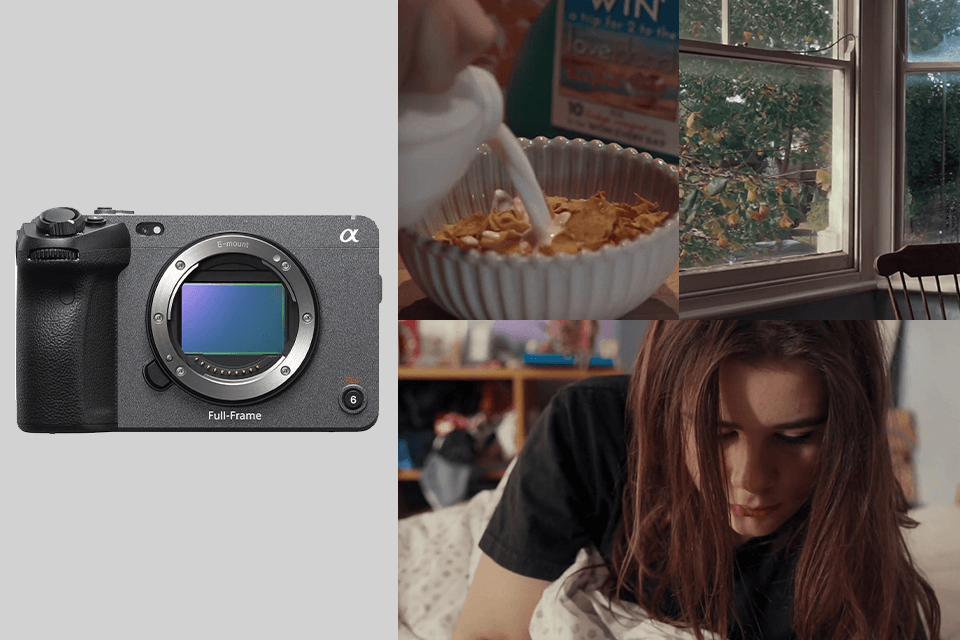
After using the Sony FX3 for more than a year, the FixThePhoto team and I have decided to thoroughly test this cinema camera. It has a portable design and does not weigh much. Its convenient grip makes it suitable for those who want to use it without experiencing any inconvenience. It won’t take you more than 4 minutes to mount the top handle, monitor, and a lens.
When testing the Sony FX3 in dynamic shooting scenarios, I was able to track moving subjects with ease. Besides, there were no issues caused by quick transitions between indoor and outdoor lighting. The S-Cinetone color profile allows me to achieve a cinematic style with ease.
The 15+ stops of dynamic range make it best suited for high-contrast situations, for instance, when I need to film a sunset without losing the details in the brightly lit foreground.
My colleagues at FixThePhoto decided to test out different camera settings and they wanted to capture a narrative video in a handheld mode. They were able to shoot content in the style of Mad Max: Fury Road. They were happy with the in-built image stabilization. When using Active mode, my colleagues were able to capture flawless fast-paced videos. Even though they moved a lot, the camera remained steady, which resulted in clear footage.
After analyzing our experience, we concluded that this model stands out among other cinematic cameras for its solo shooting performance. It produced professional output, making it perfect for b-roll, narratives, and run-and-gun videos. It can also be used as a superb video camera for YouTube. Thanks to the in-built cooling fan, it won’t get overheated even when you use it to record 4K 60p videos.
I put the Sony FX3 in fourth place. It lacks built-in ND filters, unlike other cameras. Besides, the battery life could be better. But generally, I love it for one-person crews and smaller teams. It's really comfortable to shoot with.
✔️ Buy it if: You are a novice or an intermediate solo shooter who want to record short films and YouTube content with impressive quality.
| Specs | Outcome |
|---|---|
|
Resolution |
2160p, 1080p
|
|
Optical zoom
|
2 multiplier x
|
|
Aspect ratio |
1:1, 3:2, 4:3
|
|
Connectivity tech
|
HDMI, Wi-Fi, USB, NFC
|
|
Customer ratings
|
(4.2/5) ★★★★☆
|
Easy control & straightforward navigation
|
|
500+ bought in the past month
|
|
|
100+ sold in the past year
|

|
120+ sold in the past year
|
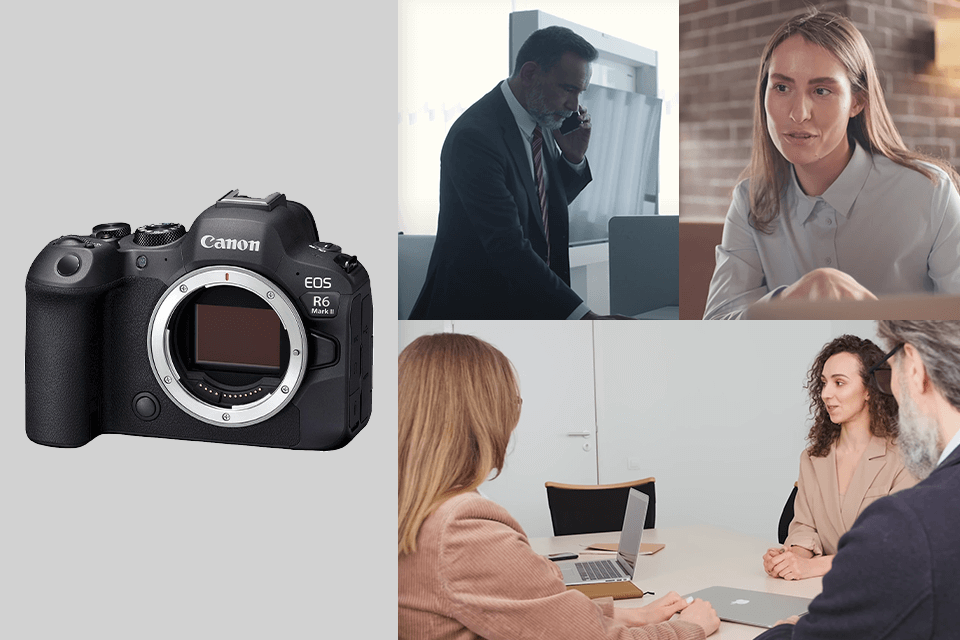
When my colleagues at FixThePhoto decided to check the functionality of the Canon EOS R6 Mark II, we rented this camera for movie making released by FotoCare. I was curious about this camera’s performance and wanted to test it out in a cinema setting.
I wanted to see how this camera copes with shooing fast-moving objects and check whether it’s suitable for shooting dynamic action videos. Besides, I was curious whether it could deal with quick transitions between indoor and outdoor lighting. It is fitted with a full-frame 24.2 MP CMOS sensor, which allows it to capture clear footage with a lot of details even in poor-light situations.
The R6 Mark II comes with an electronic shutter and supports the speed of up to 40 fps. When shooting action sports, I was able to capture athletes without any noticeable blur. It allowed me to shoot footage in a style similar to basketball scenes in Hustle.
I wanted to show every motion with a high level of detail. Unlike some other cinematography cameras, it has a fast AF system and a high frame rate, making it easier for me to capture the most important moments.
Kate decided to test Full-HD high-frame-rate and record a slow-motion video at 180 fps. She was pleased by a high level of detail and fluid movements. After analyzing the quality of the output videos we shoot, we concluded that this mirrorless camera for video is a fast, all-in-one cinema camera suitable for all shooting scenarios. Besides, it allows me to capture up to 6 hours of video in Full-HD.
I placed the Canon R6 Mark II in fifth place. It's a really good camera, but it doesn’t support lenses from other companies. Also, the HDMI port feels a bit flimsy, which made me a little nervous. However, if you need a camera that's reliable when it comes to focusing and can handle most shooting conditions, you won't be disappointed with the R6 Mark II.
✔️ Buy it if: You want to find a hybrid cinema camera suitable for capturing stills and video. It stands out for its speed, AF capabilities, and video quality, making it suitable for shooting action, narrative, and documentary films.
| Specs | Outcome |
|---|---|
|
Resolution |
4320p
|
|
Optical zoom
|
0 multiplier x
|
|
Aspect ratio |
16:9, 3:2, 4:3
|
|
Connectivity tech
|
USB, Bluetooth, Wi-Fi
|
|
Customer ratings
|
(4.3/5) ★★★★☆
|
Enhanced remote control compatibility
|
|
30+ bought in the past month
|

|
20+ sold in the past year
|
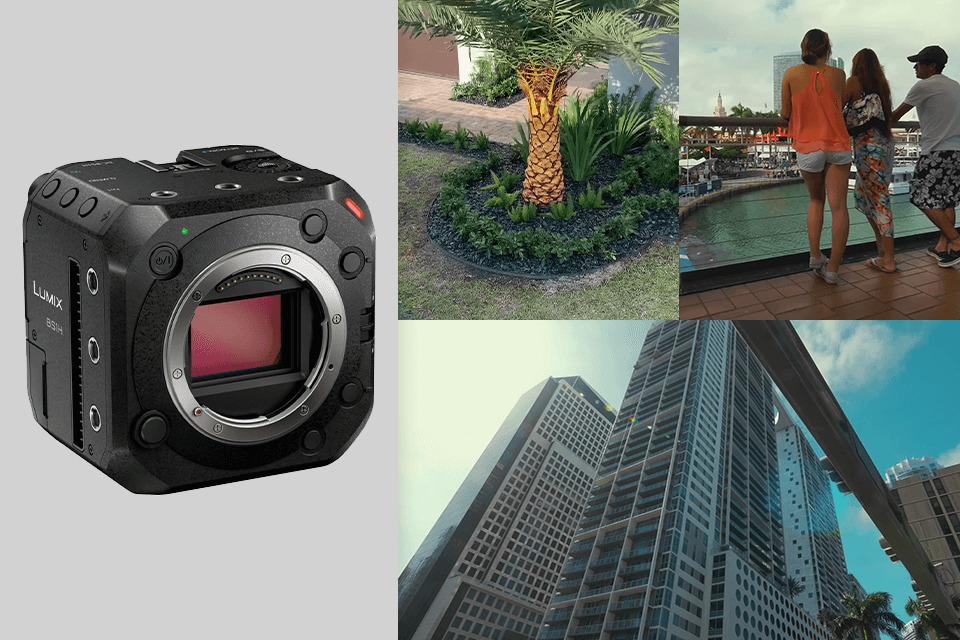
This modular box-style camera is different from other options on this list, so I could not wait to test it out. Even though it does not have an integrated screen, it’s quite convenient to use. We put it on a tripod and connected it to an Atomos Ninja V external recorder to streamline monitoring and recording. I paired it with a Panasonic 24-70mm f/2.8 zoom lens.
This Panasonic camera comes with 8 buttons and a scroll wheel for better control. This full-frame cinema camera for indie filmmakers supports 12-bit RAW output, which allows me to capture top-quality footage. I did not notice any issues when shooting in low-light situations, including at dusk.
What impressed us about this camera is that it captured fine details even in poorly lit areas. When shooting at sunset, I was able to recreate the mesmerizing style of Blade Runner 2049. The 14+ stops of V-Log and V-Gamut make it easier to enhance footage during post-processing. Besides, the camera stands out for its dynamic range and color depth.
My colleagues at FixThePhoto decided to test this cinema camera for Netflix productions using a bit different setup. They were working during a live event and were impressed by the connectivity options of this camera. They especially liked such features as Genlock IN and Timecode IN/OUT, which helped them synchronize the camera with other models used on set.
The Panasonic BS1H landed in sixth place. One of its biggest strengths is its ability to record in 6K. You can also customize it in accordance with your current workflow. Frankly speaking, it's not the prettiest camera and the autofocus can be a bit finicky. Because of this, it's probably better suited for filmmakers with very specific needs rather than those who want a camera for general use.
✔️ Buy it if: You want an all-in-one solution: with its convenient square design, this cinema camera is suitable for every situation.
| Specs | Outcome |
|---|---|
|
Resolution |
6K
|
|
Optical zoom
|
-
|
|
Aspect ratio |
3:2, 4:2:0 |
|
Connectivity tech
|
Wi-Fi, Bluetooth, USB
|
|
Customer ratings
|
(4/5) ★★★★☆
|
Compact size
|
|
50+ sold in the past year
|
|
|
25+ sold in the past year
|

|
10+ sold in the past year
|
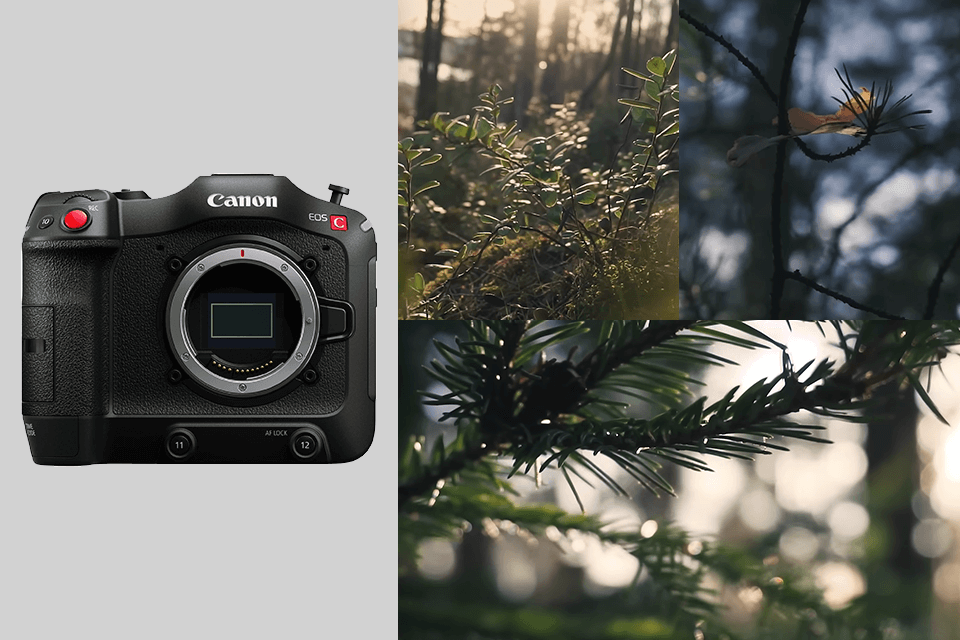
When I started to test the Canon EOS C70 camera together with my colleague from FixThePhoto, I was pleased by its functionality. We used this professional movie camera in different shooting scenarios, including in a studio environment with professional lighting and outdoors, during golden hour and at dusk filming macro of trees as you see on the example above. Even though it’s quite portable, this DSLR camera for video has 18 buttons, 13 of which can be customized to your liking depending on the goal you want to achieve.
Its 3.5-inch LCD screen makes it an excellent choice for those who want to capture videos from various angles, including low and overhead shots. It can be rotated 180 degrees, which facilitates using it in selfie mode. This camera is often used by vloggers and those who prefer shooting films solo. One of my colleagues liked its streamlined and intuitive menu.
This Canon camera for video allows me to capture content with rich colors and 16+ stops of dynamic range. When shooting outdoors at dusk, this camera for movies delivers great results thanks to the DGO technology. It allows it to capture details with high accuracy in highlights and shadows. You won’t notice any noise.
When testing its 4K 120fps and 2K 180fps modes, I was impressed by the camera’s performance. The slow-motion footage looked flawless. Whether you need to record water splashes in a studio or dynamic action outdoors, the high frame rate supported by this camera allows it to capture perfectly sharp footage.
The Canon C70 takes the seventh place. It's a small and handy camera that meets Netflix's requirements. But the screen feels a bit fragile, it can't record in RAW, and there's no viewfinder built into the camera. Therefore, I don’t think it is suitable for professional productions.
✔️ Buy it if: With 4K 120p this is an excellent camera with slo-mo support - it can even do 180fps in 2K.
| Specs | Outcome |
|---|---|
|
Resolution |
4K
|
|
Optical zoom
|
-
|
|
Aspect ratio |
16:9
|
|
Connectivity tech
|
Wi-Fi
|
|
Customer ratings
|
(4.1/5) ★★★★☆
|
Our readers heavily rely on our guides, therefore the team of FixThePhoto always delivers only authentic and proven info. We tested such models as Blackmagic Pocket 6K, Sony FX6, Panasonic Lumix GH6, Sony FX30, Panasonic Lumix BS1H, Sony FX3, Sony α7S III, Canon EOS R6 Mark II, Sony FX30, Canon EOS R5 C, Canon EOS C70, Canon EOS C80, Blackmagic URSA Mini, Fujifilm X-M5, Nikon Z9, SONY ILME-FX6, Panasonic X2000, Canon EOS C400, Canon XA60, Panasonic Lumix BGH1, Canon EOS C100 Mark II.
We tested each of the selected camera models that we rented at ShareGrid in NY based on the most crucial parameters like performance, design, AF modes, RAW format support, battery life, and price-performance ratio.
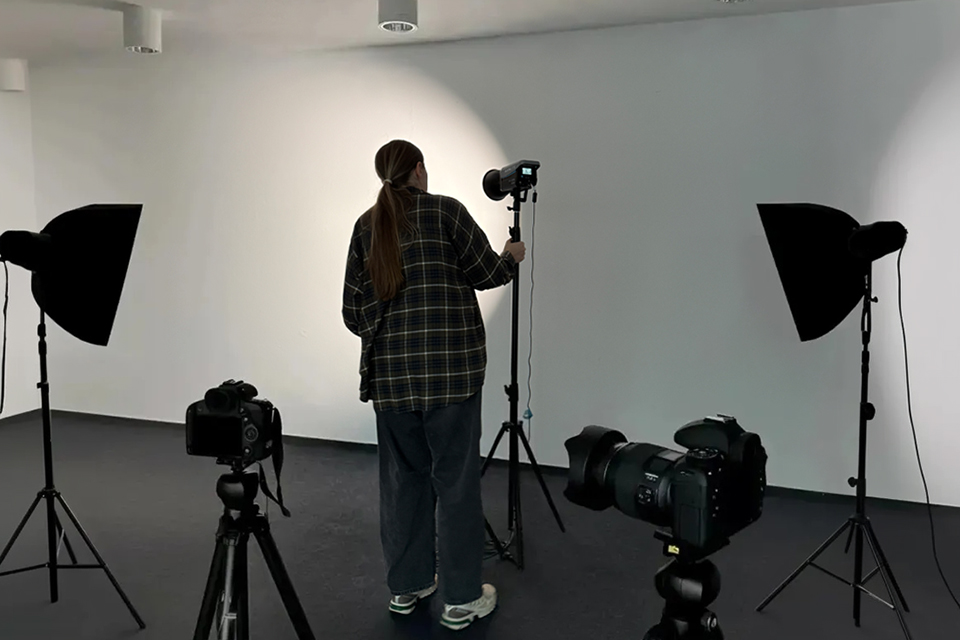
First, we evaluated the camera's design, handling, and controls to define the type of photographer it is most suitable for. For this, we tried out each model when shooting handheld and attached to a tripod to determine their strengths and startup speed.
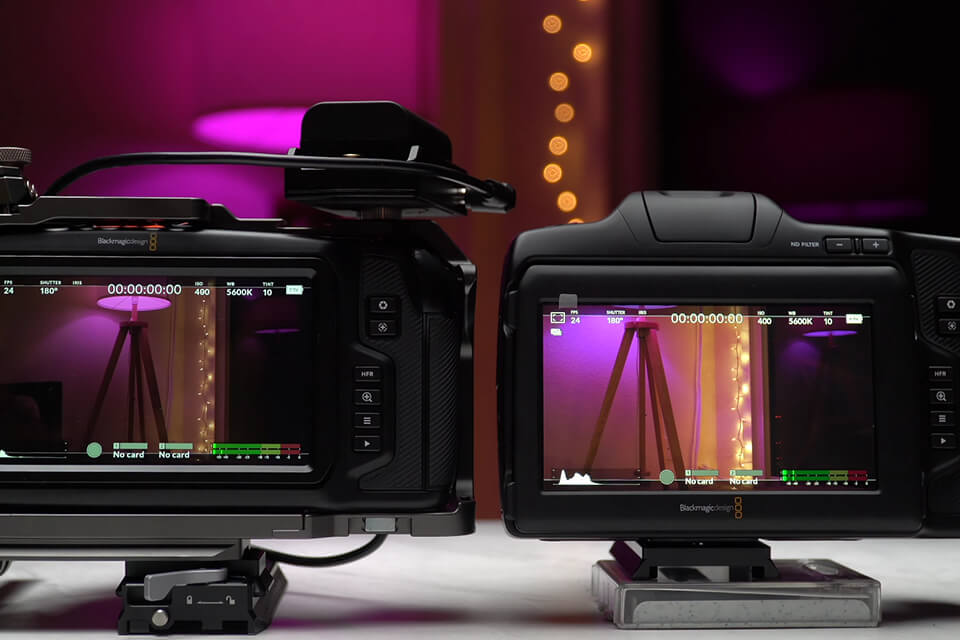
Next, we did all the needed tests to assess how well each model performs and help you choose the world best movie camera. Using the formatted and the quickest memory cards out there like UHS-I, we took pics in both RAW and JPEG formats. Then Tati Taylor and her test guys checked burst shooting capabilities by picking different burst modes and shooting sequences taking into account their length, the number of the resulting frames, and the speed of buffer clearing for both RAW and JPEG.
The performance of different AF modes in various lighting scenarios, which is pivotal for cinema cameras, was one of our priorities. Shooting multiple pics in different styles like portrait, landscape, low light, macro/close-up in raw and JPEG helped us understand the camera’s metering and sensor’s ability.
When testing the cameras with RAW format support, FixThePhoto specialists checked out some pics to see how we can enhance the shadow recovery. Accessing the camera cinematography features and ISO capabilities throughout the whole range, we defined the limits we could push the device.
Battery life was another crucial aspect our team considered when examining cine cameras. We began to test the devices with their batteries fully charged and continued until they died. Our guys compared the number of the resulting pics with the camera's official CIPA rating. We also filmed some test footage at varying frame rates and resolutions to check out the camera's video abilities.
Finally, we reviewed all the data obtained from such a comprehensive examination and the cost of each cinematography camera to make clear if they are worth their money and your investments.
We have tested over 20 movie cameras together with my colleagues and know how to choose the best model for filmmaking and digital video production. If you have never used such cameras before, it could be challenging to find the best option. To help you make an informed choice, I decided to analyze the main features of good cameras, including their sensor size, dynamic range, and recording formats.
Over the course of a week, I have been testing different budget filmmaking cameras together with my colleagues from the FixThePhoto team that includes videographers, editors, and post-production professionals. I have created a list of recommendations to assist you with finding a camera suitable for filmmakers who are looking for the best value for their money.
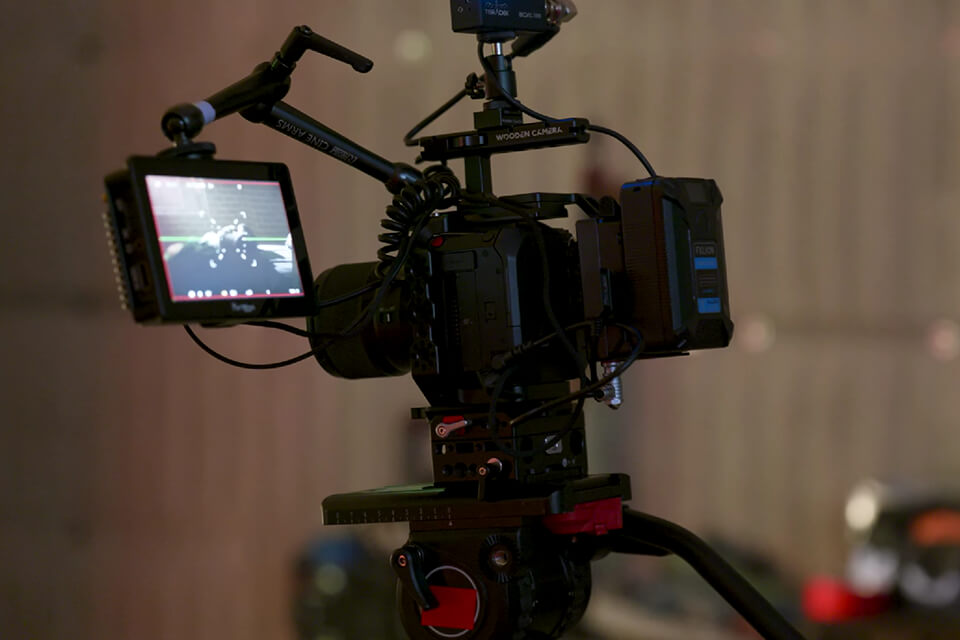
Resolution and frame rate. Most cameras for cinematic production support 4K resolution, but some models sold in a higher price bracket support 6K or even 8K resolution. However, for regular use, you hardly need such expensive models. For example, if you want to post videos online, it will suffice to use 1080p cameras. Besides, I prefer to use movie cameras that support a high frame rate ranging from 120fps to 240fps. It makes them suitable for capturing slow-motion content.
Sensor size. When looking for a camera for cinematic video, I typically consider the sensor style, as it allows me to fully transform the quality of my footage. A full frame cinema camera is suitable for those who want to capture footage with a shallow depth of field even in poor-light conditions.
Using them, I can capture cinematic shots. However, when I have a limited budget or need to find a camera for different shooting situations, a Super 35mm is the perfect option for my needs. Cameras with micro four thirds sensors are useful in situations when I need to use a compact model.
Dynamic range. Cameras with a wider dynamic range allow me to work in poor light conditions and capture images with a high level of detail both in dark and highlighted areas. Models with at least 12-14 stops of dynamic range make it easier for me to enhance my content during post-processing, as I can perform color grading with ease.
Autofocus. If you want to better control your shots and capture fast-moving subjects, it’s better to use a cinematography camera with decent AF capabilities. However, I enjoy using manual focus more, as it allows me to achieve high precision. The choice depends on the shooting technique you prefer.
Codec and Bit Depth. ProRes or DNxHR codecs are widely used by those who want to shoot footage of cinema quality. It’s better to record footage in RAW, as it allows you to edit it at a professional level. However, such videos take up more space. Make sure to use a cinematic camera with 10-bit or higher color depth if you want to perform color grading like a pro.
Build and ergonomics. It’s better to use cinema cameras with intuitive functionality, especially if you work for long hours. When choosing the right model, consider cameras with reliable grip designs, extensive customization options, and decent build quality. Some models are fitted with modular rigs, which makes it easier to use them.
Post-production workflow. Think about whether a specific camera can become an integral part of your post-production workflow. Cameras that support open standards like ProRes or CinemaDNG capture footage that is easier to edit using such pro-level software as Adobe Premiere, Final Cut Pro, or DaVinci Resolve. If you want to perform color grading often, take a closer look at a camera for cinematic videography with dedicated features that facilitate tweaking hues.
Audio and сonnectivity. Capturing clear sound requires using pro-level built-in microphones. Besides, a camera should have several inputs (XLR, 3.5mm) to allow you to capture high-quality audio recordings. It’s advisable to choose a camera with a variety of outputs to streamline the monitoring process. It should be compatible with external devices like monitors, recorders, and wireless transmitters